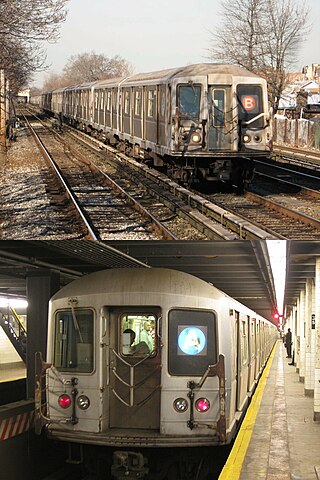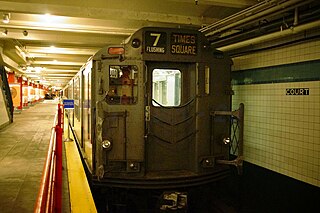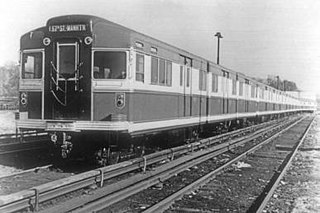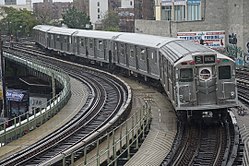
The R1 was the first New York City Subway car type built for the Independent Subway System (IND). 300 cars were manufactured between 1930 and 1931 by the American Car and Foundry Company, numbered 100 through 399, all arranged as single units. Nicknamed City Cars, the R1s were the first of five subway car classes collectively referred to as the R1–9 fleet, with future passenger stock orders – including contracts R4, R6, R7/A, and R9 – being virtually identical, with minor mechanical and cosmetic variations.

The R32 was a New York City Subway car model built by the Budd Company from 1964 to 1965 for the IND/BMT B Division. A total of 600 R32s were built, numbered 3350–3949, though some cars were re-numbered. The R32 contract was divided into two subcontracts of 300 cars each: R32 and R32A ; the former was paid by the city's capital budget and the latter was paid through a revenue bond. All were arranged as married pairs.

The R44 is a New York City Subway car model built by the St. Louis Car Company from 1971 to 1973 for the B Division and the Staten Island Railway (SIR). The cars replaced many R1-R9 series cars, and all remaining 1925 Standard Steel built SIRTOA ME-1 trains, providing Staten Island with a new fleet of railcars. The R44 fleet originally consisted of 352 cars, of which 57 remain in service, all on the Staten Island Railway.

The R42 was a New York City Subway car model built by the St. Louis Car Company between 1969 and 1970 for the IND/BMT B Division. There were 400 cars in the R42 fleet, numbered 4550–4949. It was the last 60-foot (18.29 m) B Division car built for the New York City Subway until the R143 in 2001, and the last car model class to be built in married pairs.

The R40 was a New York City Subway car model built by the St. Louis Car Company from 1967 to 1969 for the IND/BMT B Division. There were 400 cars in the R40 fleet, arranged in married pairs. Two versions of the R40 were manufactured: the original 200-car R40 order built in 1967–1968, and the supplementary 200-car R40A order built in 1968–1969, with the last 100 cars of the supplementary order re-designed with straight ends. The 200 original R40s and the first 100 R40As were unique for their futuristic 10-degree slanted end and were nicknamed the R40 Slants or simply Slants. Due to safety concerns, the final 100 cars of the R40A order were re-designed with traditional straight-ends by Sundberg-Ferar and became known unofficially as the "R40M".

The R62 is a New York City Subway car model built between 1983 and 1985 by Kawasaki Heavy Industries in Kobe, Japan, for the A Division. A total of 325 cars were built, originally as single units. When the reliability of the fleet improved, they were converted to five-car sets. The cars replaced the remaining R12s, R14s, and R15s, which were all retired by the end of 1984.

The R36 was a New York City Subway car model built by the St. Louis Car Company from 1963 to 1964. The cars are a "follow-up" or supplemental stock to the A Division's R33s, which some of the cars closely resemble. A total of 424 cars were built, arranged in pairs. The order includes World's Fair cars comprising 390 cars, and Main Line cars comprising 34 cars.

The New York Transit Museum is a museum that displays historical artifacts of the New York City Subway, bus, and commuter rail systems in the greater New York City metropolitan region. The main museum is located in the decommissioned Court Street subway station in Downtown Brooklyn and Brooklyn Heights in the New York City borough of Brooklyn. There is a smaller satellite Museum Annex in Grand Central Terminal in Midtown Manhattan. The museum is a self-supporting division of the Metropolitan Transportation Authority.

The Budd Company was a 20th-century metal fabricator, a major supplier of body components to the automobile industry, and a manufacturer of stainless steel passenger rail cars, airframes, missile and space vehicles, and various defense products.

The R38 was a New York City Subway car model built by the St. Louis Car Company from 1966 to 1967 for the IND/BMT B Division. Two hundred were built in married pairs. In addition, the R38s were built to supply extra trains for service changes resulting from the 1967 opening of the Chrystie Street Connection. Moreover, the R38 was the second subway car order to be built with stainless steel exteriors, and the first subway car fleet to have air conditioning installed.

The R10 was the first series of post-war New York City Subway cars. They were built by the American Car and Foundry Company from 1948 to 1949 for the IND/BMT B Division. A total of 400 cars were built, arranged as single units. Two versions were manufactured: Westinghouse (WH)-powered cars and General Electric (GE)-powered cars. The R10s introduced many innovations, including an all-welded low-alloy high tensile (LAHT) steel construction, dynamic braking, improved propulsion, and various cosmetic features.

The R12 was a New York City Subway car built by the American Car and Foundry Company in 1948. A total of 100 cars were built, arranged as single units. Two versions were manufactured: Westinghouse (WH)-powered cars and General Electric (GE)-powered cars.

The AB Standard was a New York City Subway car class built by the American Car and Foundry Company and Pressed Steel Car Company between 1914 and 1924. It ran under the operation of the Brooklyn Rapid Transit Company (BRT) and its successors, which included the Brooklyn–Manhattan Transit Corporation (BMT), the New York City Board of Transportation, and the New York City Transit Authority (NYCTA). The cars were designed following the signing of the Dual Contracts, which called for a major expansion of the BRT. A total of 950 cars were built.

The Bluebird, formally dubbed Compartment Car by its purchaser, the Brooklyn–Manhattan Transit Corporation (BMT), was an advanced design PCC streetcar-derived subway and elevated railway car built by the Clark Equipment Company from 1938 to 1940 and used on the New York City Subway system from 1939 to 1955. A total of six units were built, with one prototype and five production units. They were among the last cars to be ordered by the BMT before the city takeover in 1940.

The R33 was a New York City Subway car model that was built by St. Louis Car Company in 1962 and 1963. The cars are a "follow-up" or supplemental stock for the A Division's R29s and closely resemble them. The cars were also referred to as R33MLs to distinguish them from the R33Ss. A total of 500 cars were built, numbered 8806–9305, and arranged in pairs.

The R16 was a New York City Subway car model built by the American Car and Foundry Company from 1954 to 1955 for the IND/BMT B Division. A total of 200 cars were built, arranged as single units. Two versions were manufactured: Westinghouse (WH)-powered cars and General Electric (GE)-powered cars.

The D-Type, commonly known as the Triplex, was a New York City Subway car class built by Pressed Steel Car Company. They were operated by the Brooklyn–Manhattan Transit Corporation (BMT) and its successors, which included the New York City Board of Transportation and the New York City Transit Authority (NYCTA). The fleet consisted of 121 cars, each arranged as three-section articulated units. Four units were built as a prototype in 1925, and the production units were built during 1927 and 1928.

The Standard Lo-V was a New York City Subway car type built from 1916 to 1925 by the Pressed Steel Car Company, American Car and Foundry, and Pullman Company for the IRT. A total of 1,020 cars were built, which consisted of 725 motors and 295 trailers. It was the third and most common "Lo-V" type car ordered for the IRT.

The MS Multi-section was a series of New York City Subway cars. They were built in prototype form in 1934 with production models built in 1936. Built by the Budd, Pullman, and St. Louis car companies, they were called "Multis" for short. They were so named because each car was an articulated car made of five sections; though the MS Multi-section fleet's lengths differed, their average length was 170 ft (52 m).






















